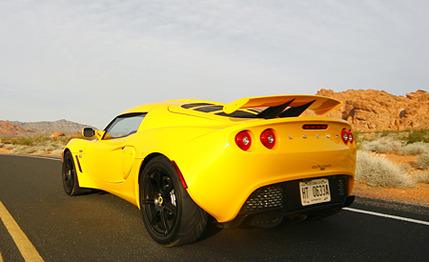 First Drive Review
First Drive Review
The Exige is a very strange car. Almost no other four-wheeled anything produces such polar-opposite responses from our staff as does the Exige, which is essentially a more-track-ready version of the already extreme Elise that Lotus brought to market last year. An announcement of an Exige purchase could be met with anything from a jealous congratulation to a sour, scrunched-up face that could be confused with the reaction given a Buick Lucerne.
For eight grand more than an Elise, the 2006 Exige added stiffer suspension settings, and hand-laid bodywork and a rear wing to increase downforce. But it offered no additional horsepower. For $57,915 (an increase of $6055) the new-for-2007 supercharged Exige S addresses that horsepower problem and replaces the Exige. It's available in the 50 Lotus dealerships nationwide as of November 2006. The special bodywork limits production to about 300 to 400 cars per year in the U.S.
Since when did a supercharger only add 30 hp?
To the Toyota-sourced 1.8-liter four-cylinder that powers Lotus' entire lineup, the company has added a Roots-type supercharger making 7 psi of boost and an air-to-air intercooler fed by the roof-mounted air scoop. Horsepower is up 30 to 220 at 7800 rpm and torque swells from 133 pound-feet to 165 at 5600 rpm. That's not a huge gain, but Lotus doesn't want to overstress the engine internals that are identical to the naturally aspirated version. That, and Lotus wouldn't want to out-do the non-street-legal, limited-edition, 243-hp, $78,990 Lotus Sport Exige Cup that has essentially the same supercharged powertrain. The Toyota six-speed manual in the Elise and Exige is carried over.
While the power gain is just 16 percent, on the street, the Exige S feels at least 50-percent stronger, especially in the mid-rpm range. That's because at 2500 rpm the new engine makes as much torque as the old engine's peak. The previously feeble mid-range in naturally aspirated form was (and still is for the unchanged Elise) the worst part of the car and a fault of the peaky Toyota engine that doesn't wake up until the 6200-rpm switchover point for the variable cam timing. The Exige S still uses the same two-position cam, but with the added torque, the switchover point is no longer perceptible. To the soundtrack, a dose of supercharger whine has been overlaid on the already fervent shriek of the high-revving four, and the redline remains at 8500 rpm despite the boost. Good luck keeping a light foot on the throttle to achieve fuel economy near the EPA 23/29 city/highway ratings.
Lotus predicts the 2100-pound Exige S (a claimed 62-pound gain) will hit 60 mph in 4.1 seconds, an improvement of 1.1 over the last Exige we've tested, and expect the quarter-mile to be similarly improved at about 13 seconds flat. Even better, there's no more 8000-rpm clutch drop to get a quick launch. Somewhere around five grand should now do the trick. Around Lotus' 2.5-mile road course at its U.K. headquarters, the Exige S is about 1.5-seconds quicker than the Exige according to Principal Vehicle Dynamics Engineer Matt Becker. And he would know.